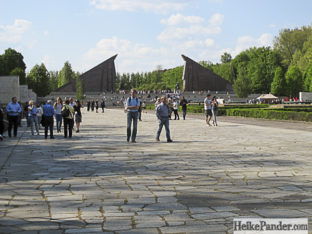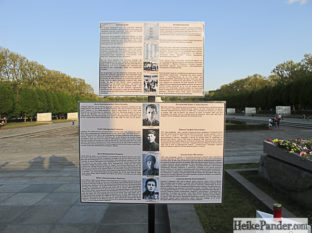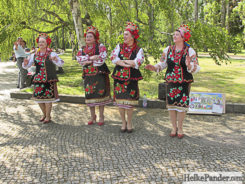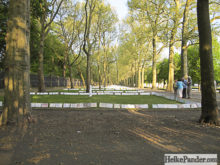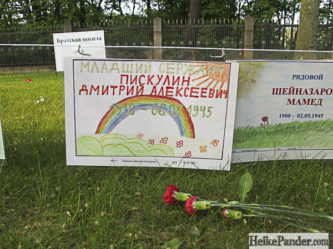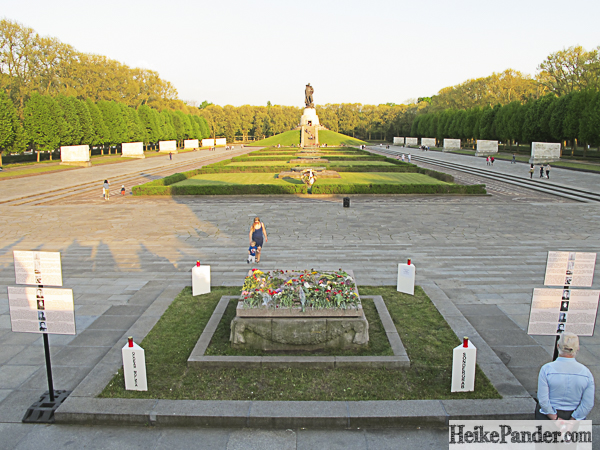
Cenotaph, Treptower Park
Birds are singing, the sun is shining – Treptower Park invites to linger in its freshly developed lush spring greenery. The park is one of the large citiy parks and covers an area of 88.2 hectares in the southeast of Berlin.
Gustav Meyer planned it in the late 19th century as a recreation area for the rapidly growing population of Berlin. He started implementing it in 1876. Construction work was finished in 1888. Large and inviting lawn areas, water ways and ponds, many trees and alleys, as well as generously curved paths mark the outline of the park and remind the onlooker of the times in which it was built. The artificially built carp pond is still a popular place. The park holds a novelty for that time: it was accessible to all citizens.
In the east the Spree with the Osthafen (East harbor) limits the park. From here excursion boats take off for sightseeing tours through Berlin. A lot of effort is currently spent on rebuilding this part of the park. The park is split by the Puschkinallee. Its appearance with the big old plane trees and ample space reminds of the times when it was built. Near the Spree, Treptower Park continues into Plänterwald.
Commercial exhibition
The park was just completed for recreational purposes as new ideas for its use came up. Merchants and industrialists of Berlin sought a world exhibition similar to those in Paris and London. However, the emperor rejected the plan.
The “Association of Berlin Merchants and Industrialists” did not give in. On the premises of the Treptower Park they organized a commercial exhibition on 900 hectares in 1896. Investors conjured an attractive blend of exoticism, festival and variety theater. A pier, a new long-distance railway station and new tram lines were built for the exhibition.
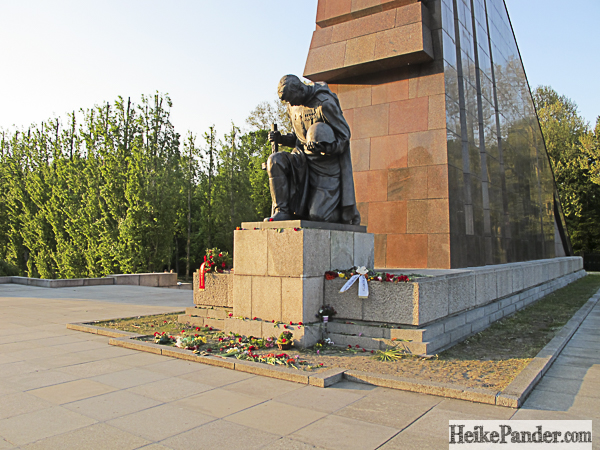
Cenotaph, Treptower Park
Cenotaph and Memorial
Embedded in the park is the Soviet War Memorial – it was built in memory for the more than 70,000 people who were killed in the period between April 16, 1945 and May 2, 1945 in the battle of Berlin. After 1945 it was built on 10 hectares of the former playground and sports field of the park. In the common graves over 7,000 Red Army soldiers found their final resting.
Once a year the otherwise rather contemplative Park shows a very different face – it turns into a magnet for the public, especially for people from the former Soviet Republics. On May 8, Europe commemorates the end of war and the capitulation of Nazi Germany. The countries of the former Soviet Union are in a different time zone – ahead of our time. Therefore they celebrate May 9th as their day of Victory.
Even 71 years after the war, hundreds of people come to visit the memorial in the park – relatives of soldiers and people who want to maintain the memory of May 8 alike. The atmosphere is rather like on a Fairground, information boards are up, folkloric performances take place, Russian music is played and culinary delights are provided.
At each common grave handwritten and brightly painted nameplates are suspended on strings of those soldiers who could be identified. Visitors carry signs with the name of their relatives, bring flowers and place them on the graves. Even a delegation of the “Night Wolves” – a Putin-related, national-patriotic motorcycle group from Russia, laid a wreath. They left Russia at the end of April on their motorbikes to celebrate in Berlin.
After two eventful days finally silence arrives at the park – only nightingales and numerous other birds sing in competition and with a little luck one can see a frightened fox running with a fluttering tail.
The Treptower Park starts at the S-Bahn station “Treptower Park” (lines 8, 9, 41, 42, 85) and can be reached easily with the buses 165, 166 and 265.





